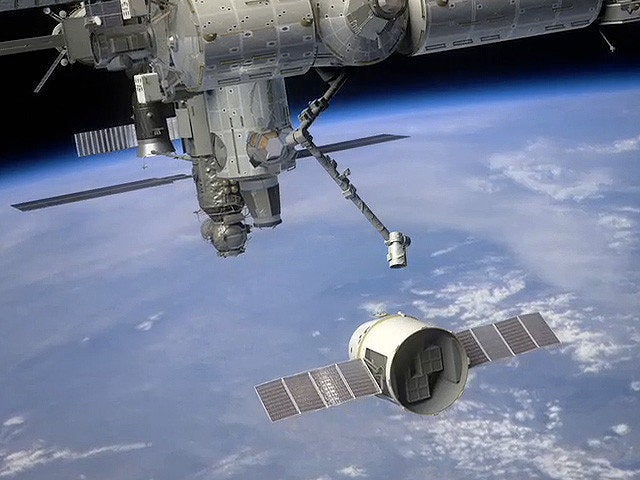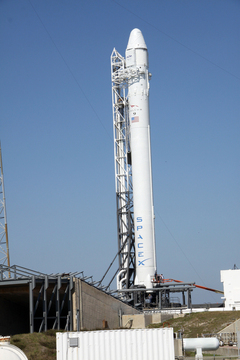
co-authored with Douglas Dechow
Last Friday night, we stayed up late to watch the launch of the Dragon capsule. Anna watched NASA-TV, and Doug watched the SpaceX broadcast. Because the launch of this commercial venture to replace the space shuttle for U.S. transport to the International Space Station had been delayed before, we didn't rush to Kennedy Space Center to watch the launch in person. We'd done that four times to see the space shuttle. Admittedly, having seen the last two shuttle launches in person, we didn't know how we'd feel about watching this test of launch and rendezvous by Space Exploration Technologies, otherwise known as SpaceX. So we choose to keep our distance.
 As the hours elapsed on Friday afternoon and evening with no problems, we started to regret our decision not to fly cross-country, stay up all night, and wait for hours among the mosquitos. A few weeks earlier, Garrett Reisman, a former shuttle astronaut and now senior engineer at SpaceX, had assured us that, although there is always the possibility of a small problem delaying a rocket launch for a couple of days, the Dragon capsule atop the Falcon 9 rocket would be absolutely ready to go on May 19. As the countdown clock continued its steady slide, we became convinced that Reisman was right.
As the hours elapsed on Friday afternoon and evening with no problems, we started to regret our decision not to fly cross-country, stay up all night, and wait for hours among the mosquitos. A few weeks earlier, Garrett Reisman, a former shuttle astronaut and now senior engineer at SpaceX, had assured us that, although there is always the possibility of a small problem delaying a rocket launch for a couple of days, the Dragon capsule atop the Falcon 9 rocket would be absolutely ready to go on May 19. As the countdown clock continued its steady slide, we became convinced that Reisman was right.
But then the clock ticked to zero, and the rocket didn't budge. We held out breaths. We leaned toward our computer screens. No liftoff. With a launch window of just a single second, any last-minute delay meant an abort. In this case, a problem in an engine pressure valve shut down the process automatically, just a split-second before the rocket was set to go.
Lofty Ambitions guest blogger Margaret Lazarus Dean did rush to the Space Coast for the weekend launch attempt. In her "Postcard From the Earth" at the Huffington Post yesterday, she wrote,
Even though today's launch was not successful, and even though the retirement of the space shuttle has been hard on space fans -- especially people here on the Space Coast -- my experience at today's launch attempt confirms the simple and irrefutable love people have for spaceflight, the unending appeal of the idea that human being can leave the surface of the planet where we evolved.
But you might think, it's just a test. And this one is an unmanned one at that. It's just the prelude for manned re-supply missions to the space station. It's not as if NASA hasn't figured all this out before. It's not as if SpaceX isn't building on the decades of technological progress NASA already made. Low-Earth orbit is nothing new. Neil deGrasse Tyson pointed out in a tweet, "If Earth were size of a schoolroom globe, our atmosphere wouldn't be much thicker than the coat of lacquer on its surface." The International Space Station is about 230 miles away. Los Angeles is farther from Las Vegas than the space station is from the ground.
So Friday's last-second launch abort reminds us that spaceflight is hard. Really hard. And that's one reason that we bother going to space at all. President Kennedy told us that's why we plan missions to space: "not because they are easy, but because they are hard, because that goal will serve to organize and measure the best of our energies and skills, because that challenge is one that we are willing to accept, one we are unwilling to postpone." President Kennedy and Margaret Lazarus Dean are right. Irrefutable, no going back, and the present game is at the International Space Station. And we must go farther in the future.
Last night, we again stayed up to watch the launch of the Dragon capsule on NASA-TV. With the three-hour time difference for Californians, we could still get to bed by 1 a.m. The countdown again went smoothly: Stage 1 and Stage 2 auto-sequences started. Launch directors go for launch. The flight computer is in control of the vehicle. 3-2-1. Liftoff, and quickly, The vehicle is supersonic. Nine minutes into flight, it dispersed the ashes of 308 dead people, including Star Trek's James Doohan. Early this morning, a capsule designed and launched by a private company began orbiting the Earth, making its roughly 75-hour way to the International Space Station for a docking on Friday morning.
SpaceX is neither future nor failure. Based on this recent launch, SpaceX is the necessary present. As all artists (including writers like us) and scientists know, we must risk failure to make the new future. We're off to a new day and a good one.
